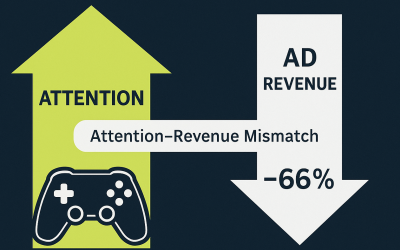Optimizing for Reward Video Ads: A Guide to Maximizing Revenue Without Compromising User Experience
The success of a mobile or Facebook app often depends on how effectively reward video ads are implemented. Well-placed ads not only enhance monetization but also contribute to a seamless user experience. Poor ad placement, however, can frustrate users and negatively impact retention. Imagine visiting a comic book store only to find kitchen appliances on display—it feels out of place and disrupts the atmosphere. This analogy applies to ad placement in apps as well. For ads to be successful, they must be aligned with the app’s experience. Here’s a guide on how to monetize with reward video ads without compromising user enjoyment.
Contents
Why Choose Reward Video Ads?
Reward video ads have gained popularity because they offer an incentive for engagement. Users are more likely to watch ads when they know there’s a tangible reward waiting for them, such as in-game currency or valuable power-ups. This mutually beneficial setup increases ad revenue while also enhancing user satisfaction.
Example: Tap Titans
Tap Titans, a popular mobile game, uses reward video ads to provide players with in-game gold, allowing them to upgrade their characters. These ads don’t disrupt gameplay or interfere with the user experience. Instead, they are presented as an optional way to earn rewards. This approach encourages players to engage with ads on their terms, increasing satisfaction and boosting retention.
Steps to Optimize Reward Video Ads
Implementing reward video ads is just the first step. For optimal results, developers must integrate ads thoughtfully and ensure they complement the game’s theme and flow. Below are strategies for effective ad integration that both increase monetization and respect the user experience.
1. Align Ad Placement with Game Flow
A crucial factor in ad placement is timing. Ads should appear at moments when they feel natural to the gameplay experience. For instance, during downtime or after completing a level, players may be more willing to watch ads. Avoid placing ads during high-action moments, as this can disrupt the experience and create frustration.
Example: Checkpoint Ads
Many games, like BLUK and Slashy Hero, offer checkpoint ads. When players reach certain points in the game, they have the option to watch an ad to gain a second chance or restart from the checkpoint. This timing feels intuitive, as players are often willing to watch an ad to recover from a loss without having to start over.
2. Tailor Ad Rewards to In-Game Needs
For reward video ads to be effective, the rewards should feel valuable and aligned with the player’s objectives. If the in-game currency or items gained from watching ads genuinely help players progress, they’ll feel more motivated to engage.
Example: Farmville 2’s Water Mechanic
In Farmville 2, water is a critical resource that limits progress when it runs out. By strategically designing the game around this mechanic, Zynga has created a built-in incentive for players to watch ads or purchase currency to obtain more water. This ad placement is both intuitive and effective, as it ties directly into gameplay and gives players control over their progress.
3. Offer Voluntary, Non-Intrusive Ads
One of the strengths of reward video ads is that they can be offered voluntarily, allowing players to choose whether or not to watch them. Voluntary ads are generally better received because they empower players and don’t feel like forced interruptions. Ensure that your ads are visible but don’t obstruct the main gameplay screen or disrupt immersion.
Example: Tap Titans’ Opt-In Ads
In Tap Titans, players are never forced to watch ads. Instead, they are given the option to view an ad to gain additional in-game currency. This approach respects player autonomy and creates a positive ad experience. By keeping ads optional, Tap Titans reduces the likelihood of player frustration while maximizing voluntary engagement.
4. Build Your Game with Monetization in Mind
Creating a game around monetization requires careful planning. Consider how ad placements will align with gameplay and what types of rewards will resonate with players. If the game includes resources or power-ups that players find valuable, reward ads can become an attractive option. Building these mechanics into the game from the start helps ensure that ads feel like a natural extension of gameplay rather than an afterthought.
Example: Integrating Ad-Dependent Rewards from the Start
A well-designed game might include a currency system where certain resources, like energy or health, deplete over time. Players can then replenish these resources by either watching an ad or making an in-app purchase. This model allows developers to optimize for both ad revenue and user experience by providing a variety of ways for players to interact with the game.
5. Avoid Ad Fatigue with Thoughtful Frequency Management
Ad fatigue can quickly set in if players are bombarded with ads. To prevent this, carefully control ad frequency by spacing out placements and monitoring player engagement. A good rule of thumb is to ensure that ads are shown sparingly and only when they feel most relevant to the player’s current gameplay state.
Best Practices to Minimize Fatigue:
- Set Limits on Daily Ad Views: Limit how many times players can view ads for rewards in a single session or day to maintain interest.
- Offer Cool-Down Periods: Implement cool-down times between ads to give players a break and avoid interrupting their experience too frequently.
Examples of Effective Reward Video Ad Implementations
Let’s take a look at some examples of games that have successfully integrated reward video ads:
1. Progression Ads in Trivia Games
Trivia and quiz games often include progression ads to help players advance by providing hints. Games like Logo Quiz and Ultimate Trivia offer hints in exchange for watching a video ad, enabling players to continue without frustration. This approach turns ads into helpful assets that players willingly engage with.
2. Checkpoint Ads in Action Games
Games like Slashy Hero and Shooty Skies allow players to restart at a checkpoint by watching a video ad. This setup respects player progress while generating ad revenue, as players are more likely to watch an ad to avoid losing their progress. Placing ads at checkpoints feels natural and supports longer play sessions.
3. Reward Ads in RPGs
In RPG-style games like Tap Titans, players can opt to watch ads to gain in-game currency or power-ups that aid their progression. This approach is especially effective in games where leveling up and collecting resources are key elements, as players are more inclined to watch ads to improve their characters.
Common Pitfalls to Avoid in Reward Video Ad Placement
While reward video ads offer great potential, there are some pitfalls to watch for. Avoiding these mistakes will help you maximize revenue without sacrificing player satisfaction.
- Interrupting Core Gameplay
Avoid placing ads during critical gameplay moments, such as in the middle of a battle or puzzle. Ads should feel like a part of the game’s natural flow, appearing during breaks or low-action points. - Offering Low-Value Rewards
If the rewards for watching an ad aren’t valuable, players are unlikely to engage. Make sure that rewards are meaningful and genuinely useful to the player. - Forcing Too Many Ads
Forcing players to watch ads too frequently can lead to frustration and increased churn. Maintain a balance between ad placements and gameplay to keep the experience enjoyable.
Final Thoughts: Creating a Balanced Monetization Strategy with Reward Video Ads
Reward video ads can be a powerful tool for monetization if implemented thoughtfully. By aligning ad placements with gameplay, offering valuable rewards, and respecting player autonomy, developers can create a positive ad experience that enhances user retention and maximizes revenue.
Building your game with monetization in mind and continuously optimizing ad placements will ensure that reward video ads become a seamless part of the user experience. By following these best practices, you can achieve a successful balance between generating income and providing a rewarding experience for players.
About AppLixir:
AppLixir specializes in reward video ads for web, mobile, and Facebook games. With AppLixir, developers can integrate intuitive, user-friendly ads that enhance gameplay and drive revenue. Visit AppLixir.com to learn more.



